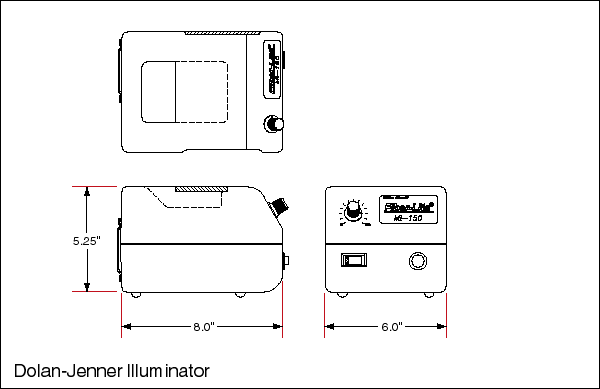
| Spannung (V) | Vergleichen | Artikelnummer | Preis | Kaufen | |
|---|---|---|---|---|---|
| 230.00 | #59-236 | €650,00 Angebotsanfrage |
|
Die Dolan-Jenner Fiber-Lite Beleuchtungsgeräte für Lichtleiter wurden überarbeitet, sie bieten jetzt eine optionale Blende und eine 5x längere Lebensdauer. Die 150 W EKE-Lampen haben eine typische Lebensdauer von 1.000 - 10.000 Stunden je nach verwendeter Intensität. Die Beleuchtungsgeräte verfügen über einen versenkten Griff und ein Seitenfach zum einfachen Austausch der Lampe. Zusätzlich sind sie ausgestattet mit einem Ein-/Aus-Kippschalter, Intensitätsregelung über Drehknopf und einem 25 mm Filterhalter mit IR-Sperrfilter. Um faseroptische Lichtleiter anzuschließen, wird der passende Dolan-Jenner SX-Adapter benötigt. Ersatzlampen werden separat verkauft.
| Titel | Vergleichen | Artikelnummer | Preis | Kaufen | |
|---|---|---|---|---|---|
| 150W EKE-X, Ersatzlampe | #59-477 | €35,00 Angebotsanfrage |
|
||
| 2.370" Innend. faseroptischer Ringlichtleiter | #58-839 | €1.045,00 Angebotsanfrage |
|
||
| 1.55" Innend. faseroptischer Ringlichtleiter | #54-174 | €700,00 Angebotsanfrage |
|
||
| 150W EKE, Ersatzlampe | #39-606 | €30,00 Angebotsanfrage |
|
||
| Faseroptikadapter MX-5, 0,191“ ID | #66-904 | €40,00 Angebotsanfrage |
|
||
| Faseroptikadapter MX-6, 0,316“ ID | #66-905 | €40,00 Angebotsanfrage |
|
||
| Faseroptikadapter MX-10, 0,565“ ID | #66-908 | €40,00 Angebotsanfrage |
|
||
| Faseroptikadapter MX-11, 0,629“ ID | #66-909 | €40,00 Angebotsanfrage |
|
||
| Faseroptikadapter SX-5, 0,191“ ID | #38-943 | €46,00 Angebotsanfrage |
|
||
| Faseroptikadapter SX-6, 0,316“ ID | #38-944 | €46,00 Angebotsanfrage |
|
||
| Faseroptikadapter SX-10, 0,565“ ID | #38-946 | €46,00 Angebotsanfrage |
|
||
| Faseroptikadapter SX-11, 0,629“ ID | #38-947 | €46,00 Angebotsanfrage |
|

1-800-363-1992
weitere regionale Telefonnummern
ANGEBOTSTOOL
Geben Sie zum Starten die Produktnummer ein.
Copyright 2025 | Edmund Optics, Ltd Unit 1, Opus Avenue, Nether Poppleton, York, YO26 6BL, UK
Die Edmund Optics GmbH Deutschland fungiert als Handelsvermittler für die Edmund Optics Ltd. in Großbritannien.
Vertragspartner ist die Edmund Optics Ltd. in Großbritannien.